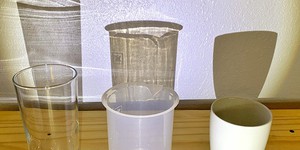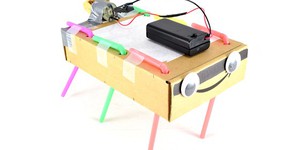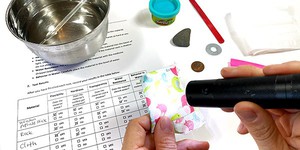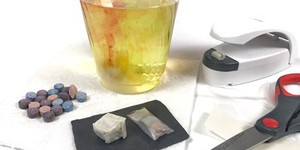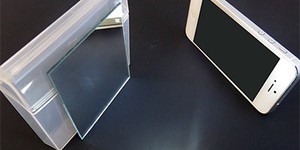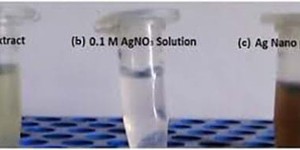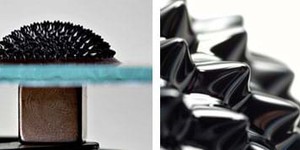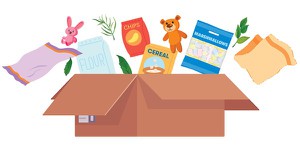Materials Science Lesson Plans (11 results)
Materials science is a fascinating area of research that is often at the cutting edge of science and engineering. It involves both developing new materials and improving on existing ones, and has important applications both for improving daily life and for advancing other fields of research. You can try your hand at making and testing all kinds of substances from plastic to slime.
|
Select a resource
Sort by
|
Lesson Plan
Grade: 1st
12 reviews
In this lesson, students explore firsthand what transparent, translucent, and opaque mean, and how they are related to light. They will place a variety of materials in front of an illuminated object and predict if and how well they will be able to see the object through the material sheet. In doing that, students will realize that different materials allow different amounts of light to pass through.
Remote learning:
This lesson plan can be conducted remotely. The Engage section of the…
Read more
NGSS Performance Expectations:
Featured
Lesson Plan
Grade: 6th-8th
7 reviews
Junkbots are easy-to-build robots that you can make using a simple circuit and some recyclable materials. In this lesson, your students will learn about engineering design as they compete to build the fastest robot. No previous robotics experience is required!
Read more
NGSS Performance Expectations:
Lesson Plan
Grade: 1st-2nd
6 reviews
Plastic, metal, wood, and stone. We encounter many different materials every day. Each object around us is made of a specific material. Why are they not all made from the same material? The answer is that every material has different properties; some are hard and others are soft, some are transparent and others are opaque. For each product that is produced, the material from which it is made determines many of its properties. This is why material testing is so important. These tests allow…
Read more
NGSS Performance Expectations:
Lesson Plan
Grade: 6th-8th
2 reviews
In this lesson, students are challenged to design and build a controlled-release tablet, which will be made from different colored bath tablets and a variety of water-soluble plastics. First, they will have to test the properties of each of the different plastic materials. Then their task will be to create a tablet that releases three different colors, each at a pre-determined time after the tablet has been submerged in water. As students design and build their controlled-release tablets, they…
Read more
NGSS Performance Expectations:
Lesson Plan
Grade: 6th-8th
2 reviews
How does light interact with matter? In this fun hands-on lesson, your students explore how different materials transmit, absorb and/or reflect light. They create their own experiments to demonstrate these phenomena and use a phones' built-in light sensor and a sensor app to add quantitative data to their arguments.
Read more
NGSS Performance Expectations:
Lesson Plan
Grade: 3rd-8th
4 reviews
Coming up with new ideas is hard! How do engineers design new things or improve existing ones? Engineers and inventors use different brainstorming techniques to help them think outside the box and come up with new ideas. In this lesson plan, your students will practice brainstorming with a method called SCAMPER.
Read more
New
Lesson Plan
Grade: 6th-12th
Create a two-part system for filtering greywater. Teams will focus on communication and systems engineering as they build separate components to filter solid and liquid waste and then combine them into one device.
Learning Objectives
Students will:
Consider the potential effects of drought and how greywater could be part of the solution.
Design a system for filtering out solid waste or liquid waste.
Consider effective communication strategies with their team.
Collaborate on their design…
Read more
Video Lesson
Grade: 2nd
1 review
Bridges are made of many different materials: steel, stone, wood and even rope. How do engineers decide which materials to use? In this activity, your students will learn about material properties, test the strength and flexibility of several materials, and use their test information to predict which material will result in the strongest bridge. They will test their hypotheses by buiding simple bridges from each material and determining which bridge can hold the most weight.
Read more
NGSS Performance Expectations:
Lesson Plan
Grade: 6th-8th
1 review
These lessons use open-ended exploration to introduce students to biopolymers and the chemistry behind cross-linking. Students will draw inspiration from biology and use authentic scientific practices to design and create colorful string creations from a natural polymer, alginate.
Learning Objectives
Students will:
Engage in authentic science practices through open-ended exploration.
Create a string using polymers harvested from living algae.
Manipulate the properties of a…
Read more
Lesson Plan
Grade: 9th-12th
Engineering silver nanoparticles for use in water filters has shown promising results in keeping water free of disinfection byproducts that arise after chlorination. In this activity, the students do individual research to learn about nanotechnology and silver nanoparticles, and how silver nanoparticles can be used in water treatment. Students choose a plant of their choice (from home, school, or from the teacher) to use as an agent to reduce silver nitrate into silver…
Read more
Lesson Plan
Grade: 9th-12th
In this fun, engaging activity, students are introduced to a unique type of fluid "ferrofluids" whose shape can be influenced by magnetic fields! Students act as materials engineers and create their own ferrofluids. They are challenged to make magnetic ink out of ferrofluids and test their creations to see if they work. Concurrently, they learn more about magnetism, surfactants and nanotechnology. As they observe fluid properties as a standalone-fluid and under an imposed…
Read more
NGSS Performance Expectations:
Lesson Plan
Grade: 6th-8th
Students will play the role of packaging engineers, exploring how to protect shipped items in innovative ways. Students will use data analysis of consumer surveys to inform the iteration of their materials and designs.
Learning Objectives
Students will:
Design a more sustainable way of packing items for shipment.
Collect consumer feedback using surveys.
Calculate averages, analyze survey data and evaluate the effectiveness of their design.
NGSS Alignment
The 3 dimensions…
Read more
|
Explore Our Science Videos
The Impossible Arrow Illusion
Is the Egg Raw or Cooked? STEM activity
Build a Mini Trebuchet

